Protein Labelling Market Size
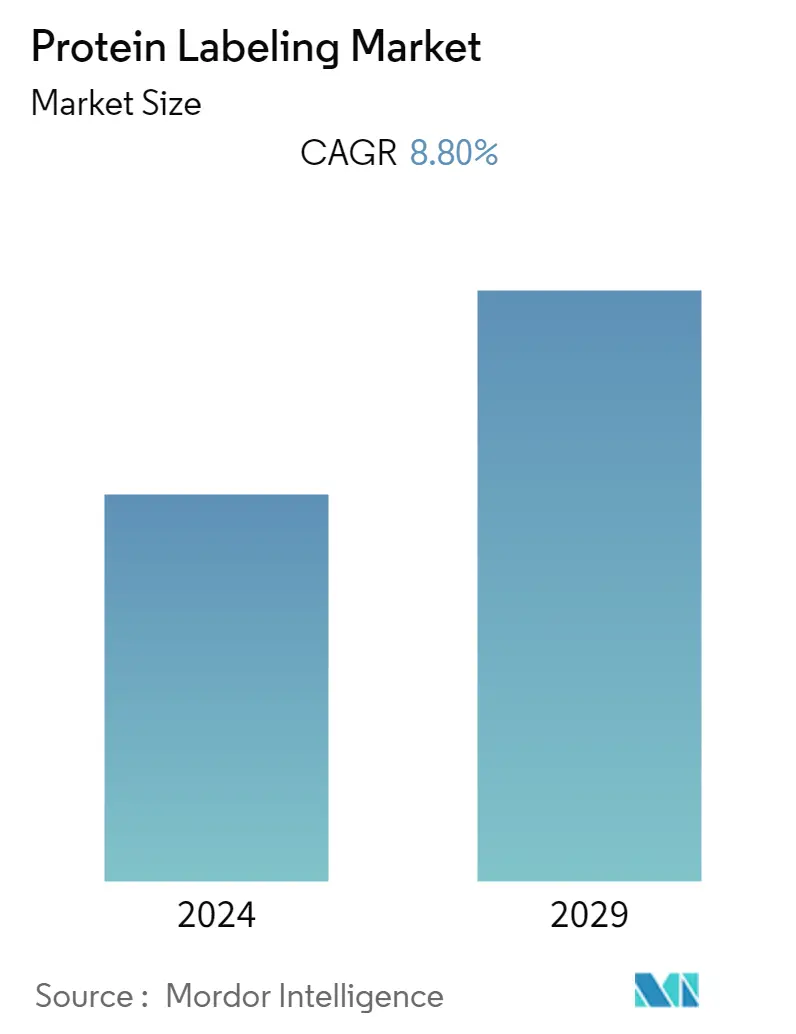
| Study Period | 2019 - 2029 |
| Base Year For Estimation | 2023 |
| Forecast Data Period | 2024 - 2029 |
| CAGR | 8.80 % |
| Fastest Growing Market | Asia Pacific |
| Largest Market | North America |
Major Players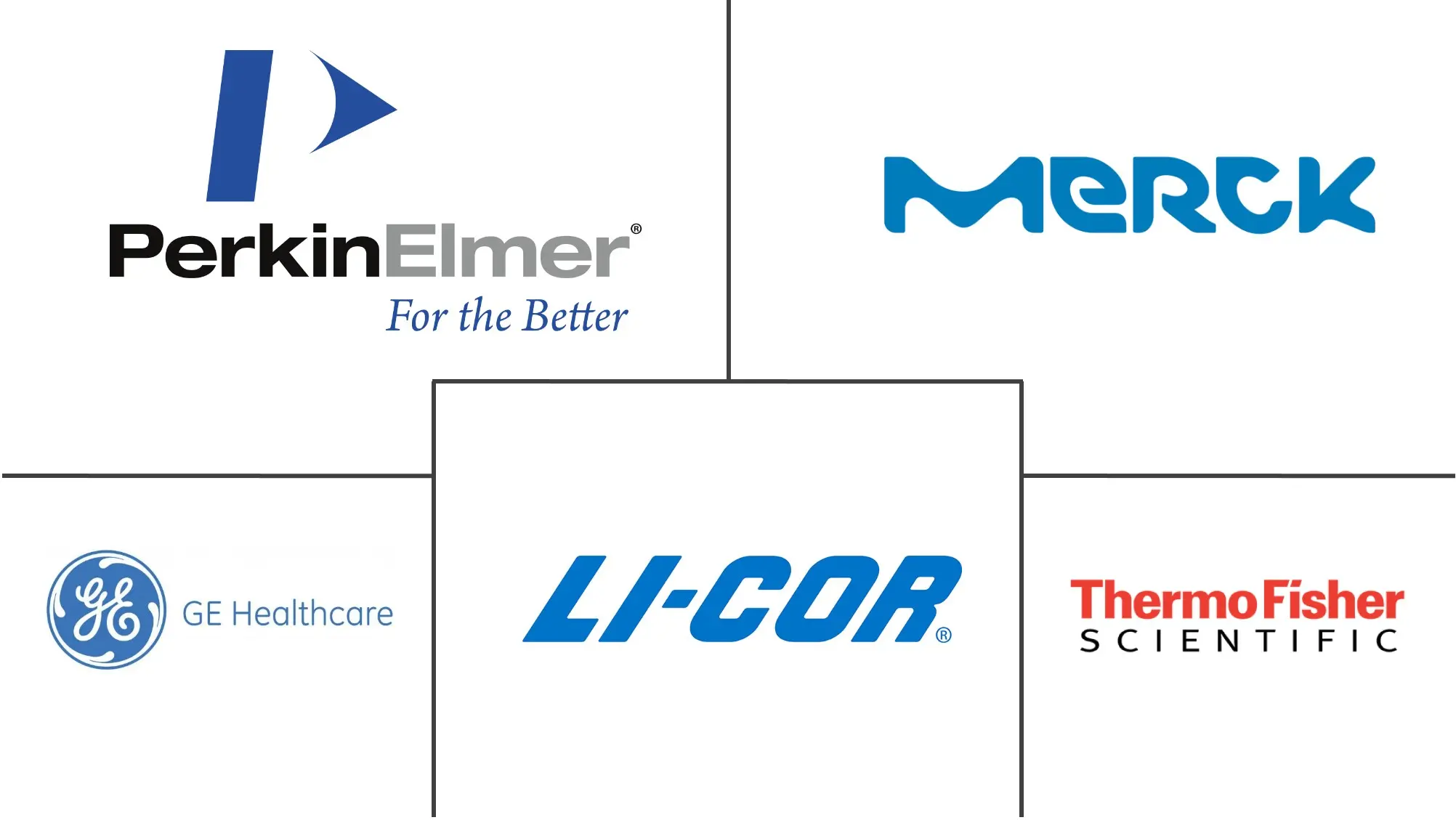
*Disclaimer: Major Players sorted in no particular order |
Protein Labelling Market Analysis
Proteins are the largest and most important biomolecules in a living organism, as they are vital to the functioning of an organism. Once they are formed within a cell, proteins interact with other biomolecules and carry out roles to keep the cell alive. Therefore, more importance is given to research the protein binding mechanism through specialized fields of studies, such as proteomics and protein chemistry.
Most of these techniques focus on the ability to specifically tag proteins by creating genetic fusions, and thereby, imparting distinctive properties for selective protein visualization, manipulation, and entrapment within complex biochemical environments. Various strategies are used to carry out successful protein labeling.
Protein Labelling Market Trends
This section covers the major market trends shaping the Protein Labelling Market according to our research experts:
Fluorescence Microscopy is Expected to Dominate the Protein Labelling Market
A fluorescent tag, also known as a fluorescent label is a molecule that is attached chemically to aid in the detection of a biomolecule such as a protein, antibody, or amino acid. Fluorescent tagging, or labeling, uses a reactive derivative of a fluorescent molecule known as a fluorophore. The fluorophore selectively binds to a specific region or functional group on the target molecule and can be attached chemically or biologically.
Protein labeling is currently being widely utilized. Protein labeling uses a short tag to minimize disruption of protein folding and function. These fluorescent proteins can used in a broad range of applications including immunochemistry, fluorescence in situ hybridization (FISH), cell tracing, receptor labeling and fluorescence spectroscopy to name a few. Thus owing to the increasing applications the market for protein labeling is exepcted to grow further in the future as well.
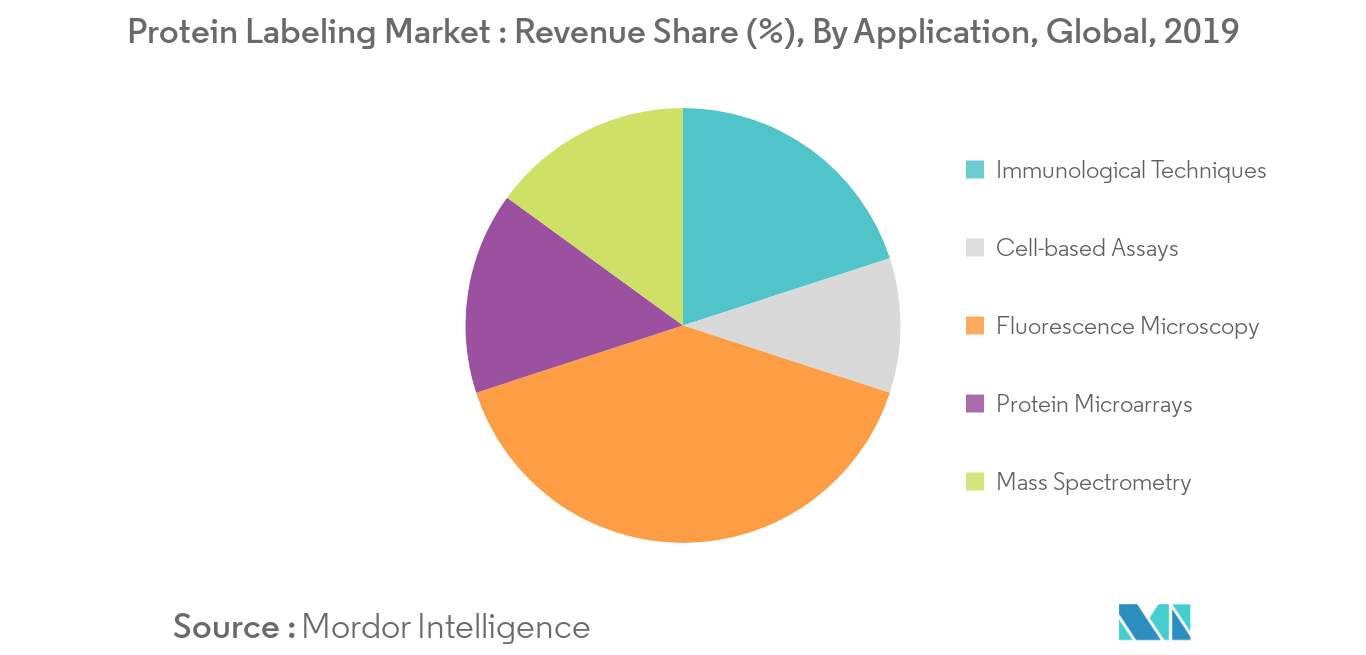
North America is Expected to Dominate the Market
The North American countries of the United States (US) and Canada have a developed and well-structured health care system. These systems also encourage research and development.
Protein Labelling as a field of research is also growing in this region due to its increasing array of applications. These countries also have policies that favor such research. These policies encourage global players to enter the US and Canada. Therefore as a result, these countries enjoy the presence of many global market players. Furthermore the increasing adoption in personalized medicine and genomic sequencing is projected to contribute toward the region’s growth in revenue throughout the forecast period.
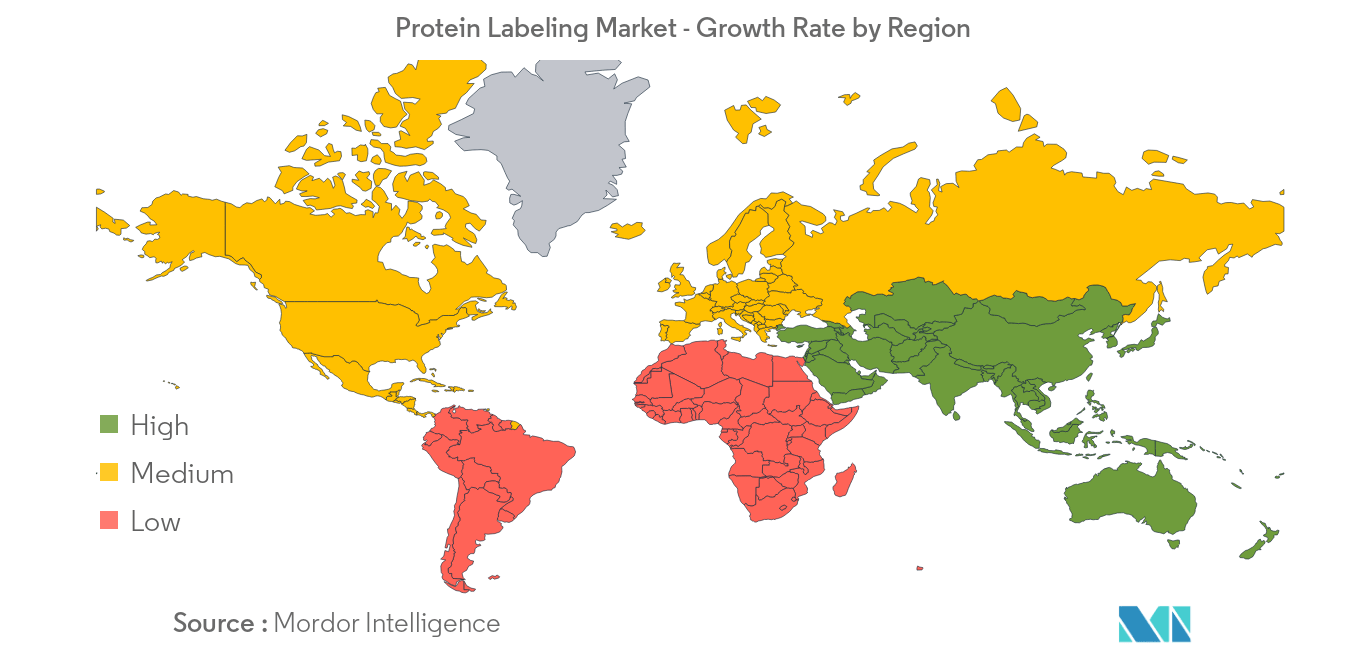
Protein Labelling Industry Overview
Majority of the protein labeling are being manufactured by the major key players. Market leaders with more funds for research and better distribution system have established their position in the market. Moreover, Asia-pacific is witnessing an emergence of some small players due to the rise of awareness. This has also helped the market grow.
Protein Labelling Market Leaders
-
GE Healthcare
-
Thermo Fisher Scientific Inc
-
Merck KGaA
-
Perkinelmer Inc
-
LI-COR Biosciences
*Disclaimer: Major Players sorted in no particular order
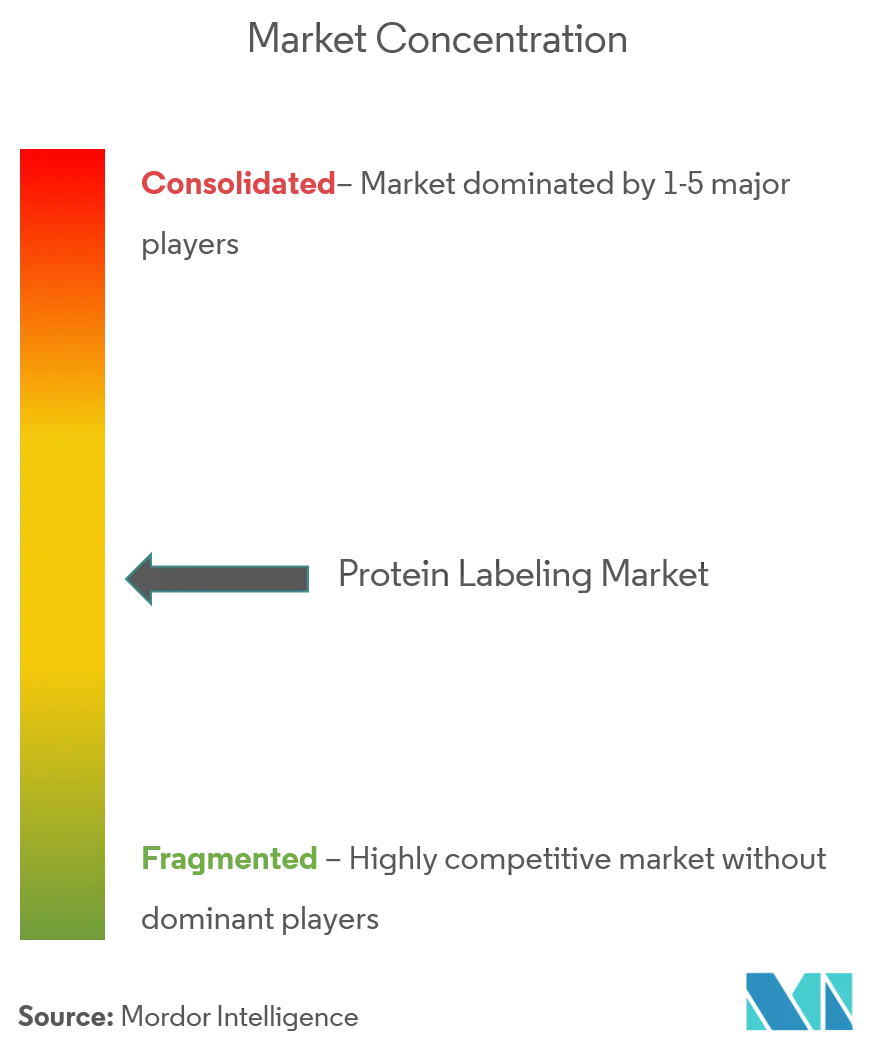
Protein Labelling Market Report - Table of Contents
1. INTRODUCTION
- 1.1 Study Deliverables
- 1.2 Study Assumptions
- 1.3 Scope of the Study
2. RESEARCH METHODOLOGY
3. EXECUTIVE SUMMARY
4. MARKET DYNAMICS
- 4.1 Market Overview
-
4.2 Market Drivers
- 4.2.1 Increasing R&D Expenditure for the Development of Protein Labeling
- 4.2.2 Increasing Proteomics Research
-
4.3 Market Restraints
- 4.3.1 Lack of Skilled Professionals
-
4.4 Porter's Five Force Analysis
- 4.4.1 Threat of New Entrants
- 4.4.2 Bargaining Power of Buyers/Consumers
- 4.4.3 Bargaining Power of Suppliers
- 4.4.4 Threat of Substitute Products
- 4.4.5 Intensity of Competitive Rivalry
5. MARKET SEGMENTATION
-
5.1 By Product
- 5.1.1 Reagents & Kits
- 5.1.2 Services
- 5.1.3 Other Products
-
5.2 By Application
- 5.2.1 Immunological Techniques
- 5.2.2 Cell-based Assays
- 5.2.3 Fluorescence Microscopy
- 5.2.4 Protein Microarrays
- 5.2.5 Mass Spectrometry
-
5.3 By Labeling Method
- 5.3.1 In-vitro Labeling
- 5.3.2 In-vivo Labeling
-
5.4 Geography
- 5.4.1 North America
- 5.4.1.1 United States
- 5.4.1.2 Canada
- 5.4.1.3 Mexico
- 5.4.2 Europe
- 5.4.2.1 Germany
- 5.4.2.2 United Kingdom
- 5.4.2.3 France
- 5.4.2.4 Italy
- 5.4.2.5 Spain
- 5.4.2.6 Rest of Europe
- 5.4.3 Asia-Pacific
- 5.4.3.1 China
- 5.4.3.2 Japan
- 5.4.3.3 India
- 5.4.3.4 Australia
- 5.4.3.5 South Korea
- 5.4.3.6 Rest of Asia-Pacific
- 5.4.4 Middle-East and Africa
- 5.4.4.1 GCC
- 5.4.4.2 South Africa
- 5.4.4.3 Rest of Middle East and Africa
- 5.4.5 South America
- 5.4.5.1 Brazil
- 5.4.5.2 Argentina
- 5.4.5.3 Rest of South America
6. COMPETITIVE LANDSCAPE
-
6.1 Company Profiles
- 6.1.1 General Electric Company
- 6.1.2 Perkinelmer Inc
- 6.1.3 Thermo Fisher Scientific Inc
- 6.1.4 Merck & Co Inc
- 6.1.5 F. Hoffmann-La Roche AG
- 6.1.6 Kaneka Corporation
- 6.1.7 Promega Corporation
- 6.1.8 Li-Cor Inc
- 6.1.9 New England Biolabs Inc
- 6.1.10 SeraCare Life Sciences Inc
- *List Not Exhaustive
7. MARKET OPPORTUNITIES AND FUTURE TRENDS
** Subject To AvailablityProtein Labelling Industry Segmentation
As per the scope of the report, protein labeling refers to the use of the appropriate molecular labels to detect or purify the labelled protein and its binding partners. Labeling strategies result in the covalent attachment of different molecules, including biotin, reporter enzymes, fluorophores and radioactive isotopes, to the target protein or nucleotide sequence
| By Product | Reagents & Kits | |
| Services | ||
| Other Products | ||
| By Application | Immunological Techniques | |
| Cell-based Assays | ||
| Fluorescence Microscopy | ||
| Protein Microarrays | ||
| Mass Spectrometry | ||
| By Labeling Method | In-vitro Labeling | |
| In-vivo Labeling | ||
| Geography | North America | United States |
| Canada | ||
| Mexico | ||
| Geography | Europe | Germany |
| United Kingdom | ||
| France | ||
| Italy | ||
| Spain | ||
| Rest of Europe | ||
| Geography | Asia-Pacific | China |
| Japan | ||
| India | ||
| Australia | ||
| South Korea | ||
| Rest of Asia-Pacific | ||
| Geography | Middle-East and Africa | GCC |
| South Africa | ||
| Rest of Middle East and Africa | ||
| Geography | South America | Brazil |
| Argentina | ||
| Rest of South America |
Protein Labelling Market Research FAQs
What is the current Protein Labeling Market size?
The Protein Labeling Market is projected to register a CAGR of 8.80% during the forecast period (2024-2029)
Who are the key players in Protein Labeling Market?
GE Healthcare, Thermo Fisher Scientific Inc, Merck KGaA, Perkinelmer Inc and LI-COR Biosciences are the major companies operating in the Protein Labeling Market.
Which is the fastest growing region in Protein Labeling Market?
Asia Pacific is estimated to grow at the highest CAGR over the forecast period (2024-2029).
Which region has the biggest share in Protein Labeling Market?
In 2024, the North America accounts for the largest market share in Protein Labeling Market.
What years does this Protein Labeling Market cover?
The report covers the Protein Labeling Market historical market size for years: 2019, 2020, 2021, 2022 and 2023. The report also forecasts the Protein Labeling Market size for years: 2024, 2025, 2026, 2027, 2028 and 2029.
Protein Labeling Industry Report
Statistics for the 2024 Protein Labeling market share, size and revenue growth rate, created by Mordor Intelligence™ Industry Reports. Protein Labeling analysis includes a market forecast outlook to 2029 and historical overview. Get a sample of this industry analysis as a free report PDF download.



